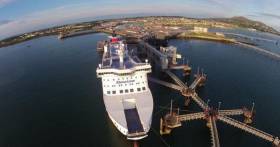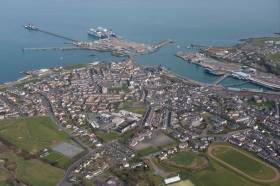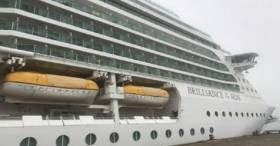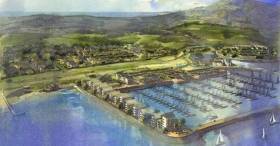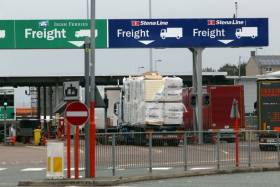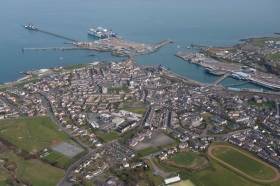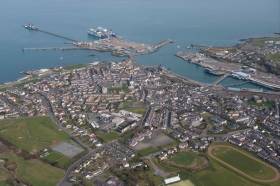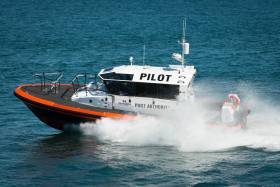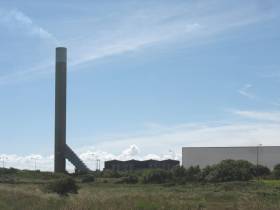Displaying items by tag: Port of Holyhead
UK's Second Biggest Ferry Port of Holyhead 'Absolutely Not' Ready for a No-Deal Brexit
The UK's second biggest roll-on roll-off ferry port of Holyhead is from where Gwynedd Shipping operate and say they are "absolutely" not ready for a no deal Brexit.
Andrew Kinsella, Managing Director of the shipping company speaking on ITV News, (see: footage) says the infrastructure they need to avoid a backlog of lorries on the A55 is not in place and it is "implausible" that it will be in time.
Stena Line, the company who manage the port in Holyhead claim they "have taken all prudent steps" to prepare for a no deal Brexit.
Welsh Government have also said in the event of a no-deal, there are likely to be delays at customs but contingency plans are in place to minimise disruption.
Boris Johnson has indicated he wants a deal largely in place by October 11, the day the agenda is set for the European summit on October 18 when the Prime Minister is hoping EU leaders will sign off on an agreement.
Michael Gove, the minister in charge of no-deal Brexit preparations (yesterday) announced, "if the EU does not move this Government is prepared to leave without a deal on October 31."
For much more from the ITV News coverage click here.
Ticking Time Bomb That Could Spell End of the Port of Holyhead
The Port of Holyhead could become unusable if action is not taken to repair its breakwater.
The structure, reports NorthWalesLive, which is 1.7 mile long and took 28 years to build, is gradually eroding.
But if it is not repaired, the port could be be closed within the next 15 years.
Stena Ports has been carrying out day to day maintenance of the structure, but the costs of that are running at around £150,000 a year.
The mound of rubble is being worn away by waves, and experts believe it could be breached within 15 years.
Plans to repair the breakwater - the longest in Britain - are now being drawn up.
For more on the breakwater, click here.
Brexit: Demands for No-Deal Over Fears of Impact On Port of Holyhead
In north Wales, town councillors in Holyhead, have urged the government to think again about letting Britain crash out of Europe with no deal.
Fearing the impact of a clean break from the European Union, NorthWalesLive writes, that members of Holyhead Town Council have passed a motion urging the Prime Minister to act in the interests of such ports and secure a deal with Brussels.
The Port of Holyhead is the second largest (ferry)port in the UK (after Dover), handling two million passengers, half a million vehicles and 450,000 freight units a year with the Swedish company employing hundreds of workers in North Wales.
During a recent visit to the port Michael Gove, the minister in charge of Government preparation for no-deal, said that ports are “geared up” for Brexit and should avoid any significant delays and congestion.
But Stena Line, which is the town’s largest employer, has described leaving with no-deal and no trade agreement as “the worst of all possible scenarios.”
Clck here for more on the story.
#CruiseLiners - In north Wales a huge cruise ship has docked - giving thousands of tourists reports the Daily Post the chance to see the region’s sights.
The Royal Caribbean International ‘Brilliance of the Seas’, one of the biggest cruise ships to grace north Wales, returned to Holyhead Port for the second time yesterday.
People reacted with shock after seeing the 90,000 ton vessel, packed with tourists mostly from the USA, arrive in the port.
The same ship visited the port back in June, and the Welsh Government has said the cruise ship industry is one they are hoping to exploit.
Tourism minister Lord Elis-Thomas said: “It’s great news that Anglesey is welcoming passengers again today.
For more on the visit of the cruise caller, click here.
The RCI operated cruiseship Afloat adds is a new caller to the ferryport that serves Dublin, however the 2,112 passenger ship is not a stranger on the other side of the Irish Sea, having made a maiden call to the Irish capital back in 2002.
On that inaugural occasion in July, as reported for Ships Monthly (Oct. 2002) the brand new ship at almost 300m long made an astern (reverse) arrival to the port as then the ship was the largest cruiseship to enter the port. This berthing procedure was due to the confines of the port and also to enable an easy departure.
#Holyhead- Holyhead, north Wales is where a developer behind a £100m marina development is in talks to take full control of the scheme by acquiring the stake of ferry giant Stena Line.
As the Daily Post reports, Conygar Stena received outline planning permission in 2012 to build 326 homes, a 500-berth marina, retail, leisure, restaurants, hotel and office space on Newry Beach in Holyhead.
Now Conygar Investment Company hopes to take full control of the multi-million pound development.
They said work was already underway on site investigations ahead of a detailed planning application being submited.
For more on this coastal development at the port on Holy Island off Anglesea, click here.
#FerryNews - At the centre of the Conservative Party is an ongoing spat over post-Brexit customs arrangements that shows a solution remains out of reach.
As the Daily Post writes, Theresa May’s preferred new “customs partnership” model was instantly shot down in flames by Brexiteers – showing agreement within the cabinet is proving elusive, never mind completing a deal with the EU.
At the frontline of this whole battle is the port of Holyhead - often forgotten when the talk at a UK level has all been about the land border between Ireland and Northern Ireland.
Port Authority Stena Line say Holyhead’s growth has been down to the “open ports policy” and any delay as a result of custom or border checks could disturb the whole business mode.
Since the completion of the EU’s Single Market in 1993 and the removal of checks between Wales and Ireland, the volume of freight travelling between Holyhead and Dublin has increased by 694 per cent.
For much more on this story click here.
#CruiseHolyhead - The Port of Holyhead in north Wales will according to Cruise Europe welcome 34% more passengers in 2018 than this year, bringing the total to 36,000 on 43 calls.
The jetty, which is owned by Stena Line but operated by Orthios, presently takes vessels up to 310m in length. However Suzanne Thomas, head of Cruise Wales, told CE that a new multi-use berth development is being considered. It will be 340m long and hence able to accommodate vessels up to 365m in length.
“Royal Caribbean is advising us on the build and the channels and all the technical aspects with regard to the Oasis class. We are hoping it will be ready for 2020. All the stakeholders, including Stena, are still discussing the investment,” she explained.
There is also an anchorage facility which can take any size of vessel. Tenders take four minutes to arrive at the marina in Holyhead.
Every ship is greeted by a choir, a singer or Welsh dancers with many also requesting the entertainment to go on board prior to departure. When a German vessel arrives, ambassadors who speak German are part of the welcome on the jetty, in the shuttles, stationed throughout the town, and take part in Blue Badge tours. When the first call went out 220 Germans living in North Wales applied for the 50 posts. A new training programme to increase numbers is being considered.
In Holyhead cruiseship days are not just for the passengers. Thomas said: “We like to make sure that the local community are involved where possible with the local activities provided. We don’t just have activities on the jetty but a band in the town centre and a local craft market where the booths are provided free for the day. As the passengers come off the ship we give them maps, advice on transport and pamphlets on what is going on, for example three choir performances a day in the church.”
At present there is a project taking place with Royal Caribbean to set up training for hospitality students in a local college. This has already been done with Seabourn whereby the students undertook a couple of contracts at sea and then returned to work on shore with the skills they have learnt.
Fam trips, a cruise conference in 2018 and new tours are all under consideration. The latter are offered direct to the lines rather than to the tour operators. One example is to take the longest zipline in Europe which goes over a quarry.
'Jobs At Risk in Holyhead' from Hard Brexit
#ferry - A ‘hard Brexit’ writes Daily Post could see jobs lost at the north Wales port of Holyhead, the Island’s AM has warned.
Speaking at the Senedd this week, Ynys Môn AM Rhun ap Iorwerth warned that some of the 1,000 jobs at Holyhead port could be at risk if Northern Irish ports continued to enjoy a ‘soft border’ with the Republic, while more stringent checks were implemented at ports on the British mainland.
“Well over 1,000 people are still employed directly in the port of Holyhead - far more in the wider economy are reliant on the port,” Mr ap Iorwerth said during a debate at the Senedd on Wednesday.
“Four and a half million tonnes of goods pass through annually. Only Dover is bigger in terms of roll-on, roll-off services.
“But, if Holyhead has been created and defined by its port in the past, there is no hiding the threats facing it now. Any barrier to the flow of vehicles and goods is a threat to the port and is, therefore, a threat to the well-being of the people of Holyhead.
For more on this story, scroll down the page from this link.
Ferryport Invests in New Pilot Boat at Holyhead
#ferryport - An investment in a new pilot boat to be used at the north Wales ferryport of Holyhead Port took place last month.
The boat built by Holyhead Marine Services Ltd is to a design created by Camarc Design and will be used by Stena Line for pilotage operations in and out of the Port of Holyhead.
Afloat adds that asides ferryport operations see report, large cruiseships call to the port by anchoring offshore. In addition smaller sized ships can berth in the harbour's inner basin.
The pilot boat is 13 metres in length with a max speed of over 27 knots. At these speeds the boat will be fast and efficient in the role of transferring up to four pilots and two crew members to and from ships arriving and departing Port of Holyhead.
Captain Wyn Parry, Stena Line’s Irish Sea South Ports Manager said: “We’re delighted that our acquisition of the new pilot boat in Holyhead has allowed us to invest in and support the local economy. It was important for Stena Line to try and support the local maritime industry where possible and we are delighted with the design and build quality that Holyhead Marine Services have been able to provide for us."
"The new pilot boat will prove essential to the daily operations of the port in terms of embarking and disembarking the ports pilots safely on and off the ships they help guide into and out of the harbour.”
Nick Colin York, Managing Director of Holyhead Marine Services Ltd commented: “We’re very proud of the hard work that has gone into the building and design of the new pilot boat. It features a resiliently mounted wheelhouse which will give crew a comfortable and quiet working environment and a Popsure fender system which will add to the safety of operations as it spreads impact loads over a large area.”
“This craft is a welcome addition to Holyhead Marine’s portfolio of composite pilot boats designed by Camarc Design and has extended the existing range to include this smaller and more economic model. In keeping with maritime tradition, the Port Authority has christened the new boat and called it St Columba,” added Nick.
Jobs Legacy from Anglesey Aluminium At Risk of Meltdown?
#ports&shipping - When the north Wales plant of Anglesey Aluminium closed its site in Holyhead there was a commitment of a ‘jobs’ legacy to bring new work into the port town.
The closure of smelting (2009) and then re-melt (2013) operations in the town writes The Daily Post took place after nearly 40 years and saw more than 500 well paid jobs lost.
Bosses at parent firm Rio Tinto said at the time that the sprawling site and surrounding land owned by the company could help create a bright jobs future.
The future certainly looked positive with two major schemes put forward.
On the site itself Lateral Power (later Orthios Power) proposed an ambitious 500 job biomass and food plant project while Land and Lakes unveiled a scheme to develop a £120m holiday village - creating up to 600 jobs.
But both schemes have suffered major setbacks recently that now put them at serious risk.
For more including photos of the former plant, click here.
Asides the vital role of the ferry industry contributing to the port town's economy, Afloat adds that the cruise-sector is another business that has seen large ships visit the port of up to around 110,000 gross tonnage.
These ships are those belonging to the 'Grand' class operated by US brand, Princess Cruises. Among them is Caribean Princess which tends to make overnight cruise legs between Dublin Port and the Anglesey port.




























